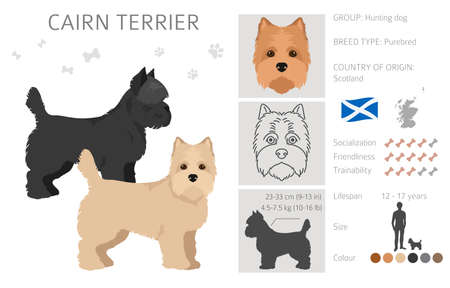Understanding Socialisation for Dogs in the UK
In the heart of British culture, dogs are not just pets—they’re cherished members of the family and regular fixtures in public life. Socialising your dog is considered an essential part of responsible ownership in the UK, where dog-friendly pubs, bustling parks, and lively high streets invite our four-legged friends to be a part of everyday experiences. But what does socialisation really mean within this distinctly British context?
The Importance of Socialising Your Dog
Socialisation refers to the process of introducing your dog to new environments, people, animals, and experiences so that they grow up to be confident and well-mannered companions. In the UK, where dogs are often expected to accompany their owners to local cafés or stroll through National Trust gardens, good behaviour is more than just desirable—it’s essential. A well-socialised dog can comfortably navigate these shared spaces, reducing stress for both pet and owner.
Dog-Friendly Culture in the UK
| Aspect | Typical British Expectation |
|---|---|
| Pubs & Cafés | Dogs should be calm and settle quietly under the table |
| Parks & Green Spaces | Friendly interactions with other dogs; reliable recall |
| High Streets & Markets | Comfortable with crowds, noise, and varied sights |
Benefits of Socialisation for Pets and Owners
- Reduces anxiety and fear-based behaviours
- Makes outings enjoyable for all family members
- Encourages positive interactions with neighbours and fellow dog owners
- Supports mental stimulation and overall wellbeing for your dog
By embracing socialisation as part of your dog’s daily routine, you’re not only meeting British behavioural expectations but also nurturing a deeper bond with your pet—one that fits seamlessly into the welcoming and vibrant fabric of UK community life.
2. Choosing the Right Puppy Classes
When it comes to socialising your dog in the UK, enrolling in a reputable puppy class is often the first step towards raising a well-mannered companion. With so many options available across Britain, making an informed decision is essential. Here’s how to choose the best puppy classes and what you can expect from the experience.
How to Select Reputable Puppy Classes in the UK
The British pet care industry places strong emphasis on welfare, positive reinforcement, and professional standards. It’s important to look for certified trainers who are members of recognised organisations such as The Kennel Club or the Association of Pet Dog Trainers (APDT UK). These credentials indicate adherence to ethical practices and up-to-date training methods.
| Key Considerations | Why It Matters |
|---|---|
| Trainer Qualifications | Ensures expertise and commitment to animal welfare |
| Class Size | Smaller groups allow more personalised attention |
| Training Methods | Positive reinforcement is gentle and effective for puppies |
| Venue Environment | A clean, safe space helps puppies feel secure and relaxed |
| Location & Accessibility | Convenient access encourages regular attendance |
What to Expect During Sessions
Puppy classes typically last between 45 minutes to an hour, creating a manageable yet stimulating environment for young dogs. The sessions often include:
- Socialisation exercises: Introducing puppies to new sights, sounds, and smells typical of British life—from passing prams to posties delivering letters.
- Basic obedience: Teaching sits, stays, recall, and polite lead walking.
- Playtime: Supervised play helps pups learn boundaries with other dogs.
- Owner Q&A: Trainers address common concerns relevant to UK dog owners, such as etiquette in public parks or navigating busy high streets.
The Role of Certified Trainers
A certified trainer does more than just teach commands—they set the tone for your puppy’s lifelong attitude towards learning and social interaction. In the UK, many trainers use reward-based methods that focus on encouragement rather than correction. This creates positive first experiences in group settings, helping puppies build confidence whether they’re exploring Hampstead Heath or strolling through local village greens.

3. Navigating Public Spaces and Parks
Introducing your dog to the great British outdoors is one of the joys of canine companionship. From leafy local parks to bustling high streets, each outing offers a chance for your pup to explore new sights, sounds, and scents. However, navigating these public spaces requires an understanding of UK regulations and a keen sense of etiquette to ensure positive experiences for both your dog and the community.
A Guide to Exploring Local Parks
Britain’s parks are havens for dog owners, providing open space for exercise and socialisation. Begin with quieter times in your local park, allowing your dog to acclimatise before venturing out during peak hours. Always use designated dog-friendly areas where available, and remember that many parks request dogs be kept on leads in certain zones to protect wildlife and children’s play areas.
Essential UK Dog Walking Etiquette
| Do | Dont |
|---|---|
| Pick up after your dog—use the provided bins | Allow your dog off-lead if unsure about recall or local rules |
| Keep your dog under control at all times | Let your dog approach strangers or other dogs uninvited |
| Respect “no dogs” signs or restricted wildlife zones | Ignore local lead laws or seasonal restrictions (e.g., nesting birds) |
Exploring High Streets and Urban Spaces
The UK’s high streets can be lively and stimulating environments for well-socialised dogs. Before you visit, check if shops or cafés display “dog friendly” signs. Many establishments offer water bowls outside as a warm welcome. Keep leads short in crowded areas and be mindful of prams, cyclists, and older pedestrians—consider practicing a calm sit while waiting at crossings or shop entrances.
Understanding Local Regulations
The UK has clear guidelines for responsible dog ownership in public spaces:
- Microchipping: Required by law for all dogs in England, Scotland, Wales, and Northern Ireland.
- ID Tag: Your dog must wear a collar with your name and address when out in public.
- Dog Control Orders: Certain areas may have specific orders regarding leads or exclusion zones; always look for signage at park entrances.
Navigating British public spaces with grace enhances your daily routine and ensures your dog becomes a welcome member of the local community—one wag at a time.
4. Socialising in Busy Urban Settings
Navigating the lively streets and bustling public spaces of UK cities can be both exciting and challenging for your dog. Urban environments such as London, Manchester, or Edinburgh offer a rich tapestry of sights, sounds, and scents, but they also present unique obstacles—from crowded pavements to an array of transport options. Here’s how you can help your dog feel comfortable and confident amidst the urban hustle.
Tips for Urban Dog Owners
Whether you’re taking the Tube or strolling through Borough Market, positive exposure is key. Gradually introduce your dog to different urban elements so they learn to take these experiences in their stride. Here are some helpful pointers:
| Urban Scenario | What to Do | Top Tip |
|---|---|---|
| The Tube or Bus | Start with off-peak hours; use treats and calm praise during journeys. | Bring a familiar blanket for comfort and ensure your dog is accustomed to lifts or escalators. |
| Markets & High Streets | Keep your dog on a short lead; practise “sit” and “wait” amidst distractions. | Reward calm behaviour and allow sniffing breaks away from foot traffic. |
| Cyclists & Joggers | Teach your dog to walk at heel; reward ignoring fast-moving people. | Use busy parks as training grounds when cyclists are present. |
| Prams & Pushchairs | Encourage polite walking by your side; practise around friends with prams first. | Stay relaxed—your calmness reassures your dog. |
| Crowds & Noise | Expose your dog gradually; retreat if overwhelmed, then try again later. | Bring high-value treats for extra encouragement in noisy situations. |
Building Confidence in the City
The British urban landscape offers endless opportunities for socialisation. Remember to respect local etiquette—keep leads short on pavements, clean up after your pet, and always check whether dogs are welcome inside shops or cafés. With patience and consistency, your four-legged friend will soon relish city life as much as you do, making every outing a joy for both of you.
5. Introducing Your Dog to British Homes & Visitors
Welcoming guests into your home is a cherished part of British culture, characterised by understated warmth and respect for personal space. Ensuring your dog is comfortable with visitors—be they human or furry friends—is vital for harmonious living. Here are some practical tips to help your dog adapt to the uniquely British style of hospitality while keeping everyone at ease.
Preparing Your Home
Before inviting anyone over, set up a calm and safe environment for your dog. Keep favourite toys and bedding nearby, and consider using baby gates or playpens if your pup is still learning boundaries. This not only reassures your pet but also shows consideration for your guests—a hallmark of good British manners.
Welcoming Guests Politely
When your visitors arrive, greet them first before allowing your dog to approach. Encourage your guests to remain calm and avoid making direct eye contact or sudden movements, which can feel overwhelming to some dogs. For those new to canine company, offer a brief introduction on how best to interact with your pup.
Guide to Greeting Etiquette
| Guest Type | Recommended Action | Notes |
|---|---|---|
| First-time Visitor | Keep your dog on a lead initially; allow them to sniff calmly before any fuss. | Offer treats for positive interactions. |
| Regular Guest | Let the dog greet at their own pace; maintain previous routines for consistency. | Praise calm behaviour; reward with gentle strokes. |
| Other Pets (with owner) | Introduce in neutral territory first, then invite inside together. | Monitor closely; provide escape routes if needed. |
The Art of British Hospitality: Subtle yet Warm
Avoid overwhelming displays of excitement; instead, model gentle greetings and quiet conversation. Encourage guests not to crowd the dog, and always respect signs that your pet needs space—true to the British appreciation of personal boundaries.
Top Tips for Success:
- Consistency: Stick to familiar routines during visits; it comforts both dogs and humans.
- Praise Calmness: Reward good manners with treats or affection, reinforcing polite behaviour.
- Respect Space: Provide a designated retreat area where your dog can relax if things become too lively.
- Cultural Consideration: If offering tea and biscuits, ensure snacks are kept out of paw’s reach!
By blending these thoughtful practices with the subtle elegance of British hospitality, you’ll foster an atmosphere where both two- and four-legged guests feel truly welcome in your home.
6. Tapping into Local Dog Communities
Once your dog is comfortable in public spaces and around other dogs, it’s time to deepen their social experience by connecting with the rich tapestry of local dog communities across the UK. Whether you live in a bustling city or a picturesque village, there are plenty of opportunities to meet like-minded dog owners and give your furry friend even more chances to socialise.
Dog Walking Groups
Joining a dog walking group is a fantastic way to let your dog interact with others while exploring new routes and green spaces. Many UK cities and towns have established groups that meet regularly in parks or countryside trails. These walks are not only beneficial for your dog’s social skills but also provide you with a chance to enjoy the great British outdoors—rain or shine!
| Group Name | Location | How to Join |
|---|---|---|
| London Dog Walkers | Greater London | Facebook Group, Meetup.com |
| Bristol Paws in the Park | Bristol Parks | Local Noticeboards, WhatsApp |
| The Northern Hound Collective | Manchester & Leeds | Instagram, Local Forums |
| Cotswolds Canine Crew | Cotswolds Villages | Village Facebook Pages |
Breed Meet-Ups
If you own a particular breed, look out for breed-specific meet-ups. These gatherings are perfect for dogs who feel most at ease among their own kind, and they give owners the opportunity to share advice on everything from grooming tips to health concerns. From Cockapoo picnics in Hyde Park to Labrador romps in Richmond, there’s something for every breed.
How to Find Breed Meet-Ups:
- Follow UK-based breed clubs on social media.
- Check event listings on The Kennel Club website.
- Ask at your local vet or pet shop noticeboard.
- Search hashtags like #SpanielMeetUpUK or #FrenchieFridays on Instagram.
Online Forums and Community Boards
The UK boasts a vibrant online community of dog lovers who organise playdates, swap advice, and share news about upcoming events. Platforms such as Mumsnet Pet Forum, DogForum.co.uk, and Nextdoor are excellent places to connect with neighbours who have pups of similar ages or temperaments. Don’t forget to check local Facebook groups or use apps like Meetup to stay informed about spontaneous gatherings near you.
Benefits of Joining Local Dog Communities:
- Your dog learns to adapt to different play styles and personalities.
- You gain access to support networks for training queries or pet care recommendations.
- You discover hidden gems—like quiet walking routes or dog-friendly cafés—that make life with your pup even more enjoyable.
- You build friendships that extend beyond the leash, strengthening community ties.
Nurturing your dog’s social life through these avenues not only enriches their world but also brings a warm sense of belonging for both of you—a true reflection of the neighbourly spirit found across the UK.


